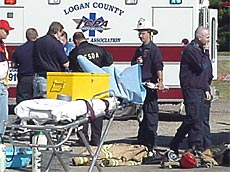|
ESDA
and LEPC conduct successful hazardous materials exercise
at water treatment plant
[OCT.
3, 2001] Shortly
after 9 a.m. on Saturday, smoke began to emerge from the Illinois
American Water Company treatment plant at 1730 N. Jefferson St. in
Lincoln. A Lincoln Police Department squad car appeared on the scene
at 9:12, responding to what was believed to be a smoke problem. The
first officer to the treatment plant door fell back gasping and
coughing, calling to his partner to stay back. So began a Logan
County ESDA and LEPC exercise testing emergency reaction to release
of a hazardous material, in this case chlorine.
|
|
From
the spectator viewing area, the unfolding scene seemed slow-moving
and low key. White wisps substituted for the yellow-green plume of
chlorine the scenario called for. Firefighters wearing standard
response uniforms and masks pulled the victim to the street in front
of the treatment plant and sat him up. The second police officer
staggered from the squad car, and firefighters also assisted him. By
9:20 an ambulance had arrived and both victims were moved toward
Feldman Drive by stretcher. Minutes passed as rescue workers checked
chemical references and developed a plan of action.

Meanwhile,
in the Crisis Management Center at the Public Safety Complex, the
smoke was identified at 9:23 as possibly chlorine gas. Computer
projections incorporating barometric pressure and wind speed and
direction indicated that the plume of gas was moving at 10 mph and
that those within half a mile were in imminent danger. Later the
zone was enlarged to 1.7 miles.
A
chlorine concentration of 40 parts per million can kill in 30
minutes, according to Logan County Health Department administrator
Lloyd Evans. High concentrations can cause emphysema, permanent lung
damage and cardiac arrest. Even 1 to 3 parts per million can mildly
irritate mucous membranes and the upper respiratory tract, he said.
Emergency
Services and Disaster Agency Coordinator Dan Fulscher assembled
Local Emergency Planning Committee members to deal with the crisis.
Fulscher and Lincoln Police Chief Rich Montcalm briefed Mayor Beth
Davis and Logan County Board ESDA chairman Doug Dutz, acting for the
board’s chairman, Dick Logan. The two elected officials decided to
block all roads into the city, call in all sheriff’s deputies and
issue a Shelter in Place order.

According
to Patrick Keane of the Illinois Emergency Management Agency, when
there is inadequate time to move people before a contaminant reaches
them, it is best for people to stay in their homes, closing all
windows and doors, shutting off air conditioners, and not drinking
water. The closer a person is to an immediately hazardous substance,
the better it is to stay inside, Keane said. It is unwise to
evacuate a person into a higher concentration than is present in the
home.
The
team decided to use all methods available to inform the public:
broadcasting through Civil Defense speakers, interrupting radio
programming, overriding cable to insert a line of instructions and
activating weather alert radios. Davis said the decision-makers were
concerned about people out in the downtown and west-side shopping
areas and so decided to phone a number of stores and have the
message broadcast at Wal-Mart. These activities, as well as others
away from the Jefferson Street scene, were not actually carried out.

The
danger zone included Abraham Lincoln Memorial Hospital, and all
three previously planned shelters not in the zone were in line with
the moving chlorine. The team therefore decided to activate a
shelter in New Holland and also to ask Lincoln Christian College for
permission to set up a shelter and triage area. In addition to
assessing the severity of injuries and beginning treatment, shelter
personnel would help track victims for families who are looking for
them.
Near
the intersection of Jefferson and Feldman Drive a child’s swimming
pool was set up for gross decontamination of victims. A spray of
water can remove much chlorine from clothing, but that water is then
contaminated and must be contained. Further decontamination would be
conducted at shelters, to protect health-care workers as well as
victims. The first two victims were decontaminated and in the
ambulance by 9:28.

At
9:34 two firefighters crawled into the treatment plant and pulled
out another victim, an Illinois American Water employee. At this
point a miraculous glitch occurred. Planners expected the employee
to be dead, since pure chlorine can kill in 7 to 10 seconds and he
had been exposed to a heavy concentration for 25 minutes.
Nevertheless, firefighters revived him. Speakers at the debriefing
session after the exercise had a hard time explaining this.
Keane,
who is Region 7 coordinator of the State Interagency Response Team,
interjected several problems into the action. One was the change in
wind direction that put ALMH in the danger zone. Another was a fire
in the communications trailer. Members of the Macon County ESDA team
then used ham radios to collect and distribute messages.
At
9:46 three firefighters returned to the plant to repair the chlorine
leak, presumably caused by an operational accident in which one tank
ruptured into another.

[to top of
second column in this article]
|

The
two who entered the building were wearing bright blue training suits
simulating the Level A totally contained Tyvex suits needed in
direct exposure to chlorine. Putting on the suits is a slow and
cumbersome process because the firefighter must be careful not to
damage the suit, according to Mark Miller, assistant chief of the
Lincoln Fire Department. The suit is quite bulky because it must
cover equipment such as the canister of purified air. In addition,
all the firefighters moved deliberately so as not to waste air.
When
the two entered the building, one reported that the smoke was so
thick he couldn’t see his own hand. They then tried to enter
through an attached shedlike structure but found that their key
would not work. Finally by 10:10 they had entered the building and
stopped the leak, shutting off the chlorine.

The
Crisis Management Center resembles NASA Mission Control without the
TV monitors. Seats are identified by title such as "CMC
Assistant Manager" or "Coroner," and people are busy
passing messages and conferring on issues. One question after the
leak was fixed was how long to continue emergency procedures. Once
the plume had passed and outside concentrations of chlorine were
less than inside, people needed to open windows but still avoid
basements because chlorine is heavier than air.
At
10:30 the Environmental Protection Agency found less than 1 part per
million of chlorine in the air. By 10:52 water tested OK. At 11:07
roads were opened, and soon after, the Shelter in Place order was
lifted. The scene was declared stable at 11:20, and city departments
were finished and ready for other calls. Evacuees were released with
written precautions from the Logan County Health Department for
re-entering their homes. They were told to flush all faucets and
clean all wet and damp surfaces before skin contact or ingestion.
The boil order for water ended, and at 11:21 the exercise concluded.

In
general, the approximately 40 participants who gathered for the
wrap-up agreed that the hours of previous meetings had resulted in a
successful operation. "I am very pleased with today’s
exercise," Fulscher said, "and quite sure that in a real
event everything will be done properly to ensure community
safety." He said such exercises bring people together to
discuss deficiencies and how to improve. Larry Adams, Montgomery
County ESDA coordinator said also, "It is easier if you know
the workings of other groups."
Fulscher
emphasized the importance of having the mayor and county board chair
participate. "It’s good that chief elected officials
understand what a Crisis Management Center is," he said,
because they play a pivotal role in decision-making.
One
issue that came up repeatedly in the assessment was communication.
One suggestion was to use common language such as saying the wind
had shifted to the north-northwest instead of to 330 degrees. Warren
Curry of the Logan County Sheriff’s Auxiliary said landmarks could
also be used for directions. Another communication problem was
cross-feeding of radio systems. Fulscher said communication would
always be the biggest problem but that during several years of
exercises it has been greatly improved.

Other
recommendations included
—Setting
up a central location for mapping information, such as ground
elevations and locations of homebound people.
—Finding
a few more ham radio operators.
—Purchasing
compasses for fire engines and squad cars.
—Putting
a warning diamond on the water plant fence to signal the chlorine
danger.
—Using
more field observers.
—Adding
more volunteers to the disaster intelligence committee.
—Holding
more "tabletop" exercises, limited to the Crisis
Management Center. Evans said, "We know the firemen and police
know how to do their job."
"Next
year’s exercise will take off from the end of this one,"
Fulscher said. Keane elaborated that it could include such issues as
directions to food handlers, verification that homes had been
ventilated and long-term effects on victims. He praised the joint
use of Logan and Macon County teams but said it would be good if the
same work could be done simultaneously in both counties to prepare
for a widespread disaster.
Keane
was one of two exercise evaluators. Larry Adams, the LEPC observer,
said his job was to ask, "Can Logan County implement their
hazardous materials plan?" His answer was a strong yes.
[Lynn
Shearer Spellman]

|
|
|
Middletown
chosen as site for Smithsonian exhibits next summer
[OCT.
2, 2001] The
Illinois Humanities Council and the Smithsonian of Washington, D.C.
have honored the Knapp/Chesnut/Becker Historical Society of
Middletown by choosing the library-museum as one of the six sites in
Illinois for the June 23 to July 28, 2002, exhibits of
"Yesterday’s Tomorrows."
|
|

[Helen helps
again! Helen Smith Staats (at left) presents a check for $2,000 to
Shelly Dobey, chair of the Smithsonian exhibits committee, and to
Bill Post, president of the Knapp/Chesnut/Becker Historical Society,
hosts of the June-July 2002 exhibits at the library-museum in
Middletown.]
Besides
all of the pies, quilts and monetary gifts she has given in the
past, Helen Staats has given a $2,000 check, which enables the K/C/B
Historical Society to meet the requirement of matching the $2,000
grant awarded by the co-sponsors of the displays.
Plans
so far include special events, focusing on themes suggested by the
Smithsonian, to be at the Middletown Park pavilion on six Sundays.
June 23 will be Transportation Sunday; June 30, Home and Country
Sunday; July 7, Technology Sunday; July 14, Culture Sunday; July 21,
Health Sunday; and July 28, Spiritual Sunday.
Shelly
Dobey chairs the steering committee of Mayor Ken Davison, Jackie
Sullivan, Kathy Sommers, Bill Post and Winnie Golden.
All-you-can-eat
turkey supper
The
annual "all-you-can-eat" turkey supper sponsored by the
K/C/B Historical Society is scheduled for Saturday, Oct. 20, from 1
to 4 p.m. at the Middle School in Middletown. This benefit is known
for excellent food and historical displays.
[News
release]
|



|
|
Tell
a friend about
Lincoln Daily
News.com |
Our
staff offers more than 25 years of experience in the
automotive industry.
Greyhound
Lube At
the corner of Woodlawn and Business 55 No
Appointments Necessary |
Advertise
your
Garage
Sale in Lincolndailynews.com
--
It's FREE! --
Click
here |
|
|
|
Domestic
abuse and violence awareness event Thursday evening
[OCT.
1, 2001] Domestic
violence hurts everyone. At a time when our country has been
impacted by senseless violence and loss, we need to come together in
a peaceful gathering and show of support for those in our own
community being affected by violence every day.
|
|
In
2000 there were 147 reported incidents of domestic battery in
Lincoln, according to a report compiled by the Lincoln Police
Department. Sixty-three of these incidents occurred while children
were present.
To
increase community awareness of this problem, the Domestic Abuse and
Violence Task Force of the Healthy Communities Partnership of Logan
County is sponsoring its second annual candlelight procession and
education event. The vigil and community gathering will begin at
6:30 p.m. Thursday, Oct. 4, on the sidewalk surrounding the Logan
County Courthouse and will feature a candlelight walk around the
courthouse.
In
the courthouse rotunda Timothy Huyett, Logan County state’s
attorney, will speak on the legal issues surrounding domestic
violence and its impact on the Logan County community. Shelley
Musser, Sojourn shelter and services specialist, will also give a
presentation.


[to top of second column in
this article]
|

The
"Silent Witnesses" and "The Clothesline Project"
will be displayed in the courthouse rotunda during the day of the
event. The Silent Witnesses are silhouette figures of individuals
who have died as a result of domestic violence. The victim’s story
is displayed on a plaque on each silhouette. The Clothesline Project
consists of shirts and sweatshirts designed by victims of domestic
violence and their families. These shirts tell the victim’s story
in her own words. Information on available community services will
also be available in the courthouse rotunda.
Please
join the Domestic Abuse and Violence Task Force for this event. For
more information or to find out how you can join the task force, you
may call Debby Cook, chairperson, at the Logan County Health
Department, (217) 735-2317.
[News
release]

|
|
|
Task
force will seek solutions for nursing home funding problems
[SEPT.
29, 2001] State
Rep. Jonathan Wright, R-Hartsburg, will serve on the House
Republican Long-Term Care Funding Task Force. Illinois House
Republican Leader Lee A. Daniels announced the formation of a
special task force last month. Their mission is to research possible
solutions to a looming funding crisis in the state’s long-term
care industry.
|
|
There
are currently 85,000 seniors and disabled people living in Illinois
nursing homes. Sixty-four percent of those rely on public assistance
to help pay for their nursing home stays. Nursing homes are to be
reimbursed by the state for the costs associated with providing care
for these individuals. According to industry experts, in many cases,
Illinois fails to provide adequate reimbursement for Medicaid
residents. The reimbursement shortfall has forced numerous
facilities to transfer the costs of doing business to their
private-pay residents, or, increasingly, to file bankruptcy.
"I
am looking forward to working on this important task force,"
Wright said, "Nursing home residents and their families deserve
the very best we can provide. This industry is providing an
invaluable service to thousands of Illinois families. State
government must recognize that, and assure that the industry has the
resources it needs to remain viable."
[News
release]
|
|
|
Mock
disaster exercise set for Saturday
[SEPT.
28, 2001] Area
emergency agencies will participate in a mock disaster exercise
coordinated by Logan County ESDA and the Logan County LEPC on
Saturday, Sept. 29. There will be a number of emergency agencies
from throughout Logan County working together in response to a
simulated hazardous materials leak at the Illinois American Water
treatment plant.
|
|
Lincoln
Police and Lincoln Fire Department will coordinate their response
with the Logan County sheriff’s deputies and auxiliary, member
departments of the Logan County Fire Protection Association, Logan
County Paramedic Association, Logan County coroner’s office and
the Logan County ESDA. The unified response will involve a simulated
leak of chlorine gas from the water treatment facility at Jefferson
Street and Lincoln Parkway.
The
Logan County Crisis Management Center, located at the safety
complex, will be fully staffed and operational. Strategic and policy
decisions required for the event will be made by government
officials and emergency services command staff located at the CMC.
Evaluators
from the Illinois Emergency Management Agency and the Illinois State
Emergency Response Commission will be at both sites to critique the
operations.
[to top of second column in
this article]
|
Citizens
will be allowed to observe the exercise at a designated spectator
area on North Jefferson Street. The exercise is scheduled to begin
at 9 a.m. on Saturday and to be completed by 11:30 a.m. Please join
us as your emergency services responders deal with the simulated
emergency.
Schedule
8
a.m. — Participants begin to assemble at the North Jefferson
Street site and the Crisis Management Center
8:15
a.m. — Optional press briefing at the Logan County CMC, 911 Pekin
St., Lincoln
9
a.m. — Exercise begins at the Illinois American Water facility,
1730 N. Jefferson St., Lincoln
11:30
a.m. — Exercise finishes
Noon
— Luncheon at the Logan County CMC for participants in the
exercise
[News
release]
|
|
|
West
side box culvert repair addressed
Letter
from Burwells to Lincoln Council
[SEPT.
28, 2001] The
following letter from the Burwells regarding the repair of the box
culvert on the west side of Lincoln was received by the mayor and
the Lincoln City Council and was released to LDN by the city of
Lincoln for publication.
|
|
[Unedited copy
of letter]
September
14, 2001
Dear
Mayor Davis and Lincoln City Council Members:
We
write to clarify the mischaracterization of the position of Burwell
family members regarding the repair of the box culvert on the west
side of Lincoln. These misrepresentations were made by Greene &
Bradford, Inc. representatives at the Tuesday, September 11, 2001
city council meeting.
The
box culvert at issue was designed by Greene & Bradford, Inc. and
constructed by R.A. Cullinan & Sons at the direction of Eric
Burwell and Curt Burwell, then owners and developers of adjacent
North Heitmann Park Addition lots. To be clear, the development on
the north side of Route 10 has no relationship with Burwell Oil
Service, Inc.
Greene
& Bradford, Inc. maintains that it had an agreement with the
former city engineer where the City of Lincoln would assume
responsibility for the maintenance of the box culvert after
completion. We cannot comment on the exact terms of this agreement
because no member of the Burwell family was personally involved with
these discussions. Instead, we were told by our agent, Green &
Bradford, Inc., that the City would in fact take responsibility of
the box culvert after its completion. Of course, this alleged
agreement was never considered or formalized by the mayor or the
city council. In other words and by its own admission at the council
meeting, Greene and Bradford, Inc. did not complete the project it
was hired to do. We learned of this incompletion only after the box
culvert was damaged and the question of who should pay for the
repairs surfaced
We
do not believe that the City of Lincoln should pay for the
repair of the damaged box culvert. The proper construction of the
box culvert is, primarily, our responsibility and we assure you it
will be completed. We firmly maintain that the damage is a result of
Greene and Bradford’s negligence, and we have communicated this
position to them on numerous occasions.
No
member of the Burwell family authorized Greene & Bradford, Inc.
to request any funding from the City of Lincoln at the September 11,
2001 city council meeting. Instead, we expressly told Mr. Jessen
that we wanted him only to present the issue of whether the City
would maintain a properly constructed drainage device, and we
expressly told both he and Mr. Greene (on numerous occasions and in
no uncertain terms) that we strongly felt Greene and Bradford, Inc.
should pay for the entire new drainage device. To the extent Mr.
Greene asked the City of Lincoln for any money to repair the box
culvert on September 11, 2001, Mr. Greene was acting on behalf of
his firm and not as a representative or agent of any member of the
Burwell family
[to top of second column in
this article]
|
We
have refused to pay for the damage insisting that Greene &
Bradford, Inc. should pay for the repair. We have refused Mr. Greene’s
invitation to file a lawsuit against his firm to activate his errors
and omissions insurance coverage. Also and contrary to a previous
misrepresentation by Greene & Bradford, Inc., we have never discussed
or even considered legal action against the City of Lincoln. Quite
simply: we don't think the City has any fault here.
Greene
& Bradford, Inc. has consistently maintained that fault should
be placed on R.A. Cullinan and Sons, however we’ve seen no
credible evidence suggesting any fault on Cullinan’s part. From
every indication we have, the box culvert was constructed according
to specifications
We're
embarrassed by the suggestion that the City of Lincoln should pay
for the box culvert because of past development in the city, Mr.
Greene’s statements regarding what Gene Burwell may or may not
have done for the city or community are irrelevant to this
situation.
We
do encourage the City of Lincoln to strongly consider taking control
of the box culvert after its proper construction. We firmly believe
that the City should maintain this drainage device to ensure its
proper operation for many years. Properties are bought and sold,
individuals and firms move or dissolve, and we feel the City of
Lincoln is the most reliable and consistent entity that will ensure
proper maintenance and operation of this important drainage device
for many years into the future
Needless
to say, we’re seriously troubled by the representations made
purportedly on our behalf at the September 11, 2001 meeting. Please
be advised that Greene and Bradford, Inc. did not represent any
member of the Burwell family in this matter at the September 11,
2001 meeting. Should anyone wish to discuss this matter further, we
invite your comments and questions.
Finally,
we will take immediate steps to resolve this matter and construct
the proper drainage device.
C.
EUGENE BURWELL
ERIC
E. BURWELL
CURT
E. BURWELL
|
|
|
Spring
construction date set for
Brainard Landing development
[SEPT.
27, 2001] Construction
of Phase 1 of Brainard Landing, an affordable apartment complex to
be developed at 21st and State streets, may begin as early as March
of next year, the Lincoln City Council learned Tuesday evening.
|
|
Thomas
Koontz, senior vice president of PEDCOR, the Indianapolis firm which
is building the complex, told the council that the company was
allocated its tax credits a month ago and hopes to begin
construction early next year. Phase 1 will include four of the eight
planned housing units and the clubhouse, which will have fitness
facilities, a computer center, a laundry and a playground. Cost of
Phase 1 will be about $4.5 million.
The
entire 56 units in the finished development will be rented to those
at or below median income —
in the $18,000 to $36,000 range, depending on
family size, Koontz said. The rental units will accept Section 8
housing vouchers.
When
completed, the complex will have 16 one-bedroom, one-bath units; 24
two-bedroom, two-bath units; and 16 three-bedroom, two-bath units.
Each will be equipped with refrigerator-freezers, electric stoves
with self-cleaning ovens, dishwashers, garbage disposals,
washer-dryer hookups, window blinds, central heating and air
conditioning, and carpeting. Each unit will also have a private
balcony or patio and a storage area, according to a PEDCOR handout.
Although
wall units may be pre-panelized, the units are not prefabricated,
according to Koontz. The units will be on concrete slabs, and no
carports or garages are planned.
[to top of second column in
this article]
|

The
facility will have three to four full-time employees, a full-time
manager on the site, a leasing agent and a maintenance staff, and
will use local contractors whenever possible, Koontz told the
council. Staff will be hired 60 days ahead of time and trained at
other PEDCOR facilities.
Koontz
said he has already had requests for about one-half of the units.
According to Mary Elston of Central Illinois Economic Development
Corporation, CIEDC’s yearly community needs assessment shows that
low to moderate income rental units have always been a high
priority.
PEDCOR specializes in
building affordable housing by taking advantage of income tax
credits that allow it to get financing at a lower interest rate,
according to development assistant Kitty Campbell. The company
presently has 6,000 units in Midwestern states and manages all its
own units, she said.
[Joan
Crabb]
|
|
|
Announcements
|
|
Back
to top
|
News
| Sports
| Business
| Rural
Review | Teaching
& Learning | Home
and Family | Tourism
| Obituaries
Community | Perspectives | Law
& Courts | Leisure Time | Spiritual
Life | Health
& Fitness | Letters
to the Editor
|
|